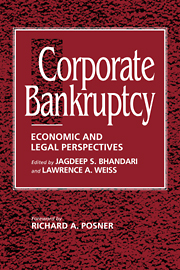Book contents
- Frontmatter
- Contents
- List of tables and figures
- Foreword by the HONORABLE RICHARD A. POSNER
- Preface
- Part I The role of credit
- Part II Bankruptcy as a reflection of the creditors' implicit bargain
- Part III Beyond the basic creditors' bargain
- Part IV Workouts or bargaining in the shadow of bankruptcy
- Part V Alternatives to bankruptcy and the creditors' bargain
- Part VI Experience of other countries
- Index
Preface
Published online by Cambridge University Press: 10 December 2009
- Frontmatter
- Contents
- List of tables and figures
- Foreword by the HONORABLE RICHARD A. POSNER
- Preface
- Part I The role of credit
- Part II Bankruptcy as a reflection of the creditors' implicit bargain
- Part III Beyond the basic creditors' bargain
- Part IV Workouts or bargaining in the shadow of bankruptcy
- Part V Alternatives to bankruptcy and the creditors' bargain
- Part VI Experience of other countries
- Index
Summary
This book has been a long time in process. It was apparent to most observers some years ago that economic analysis of law had matured. Law and economics scholars produced a multitude of papers that found their way into existing and newly begun journals. Readers or edited volumes appeared in various areas of the law such as torts, contracts, antitrust administrative law, and corporate law. For various reasons, economic analysis of bankruptcy law was somewhat slower in developing. This may appear puzzling, at first, in view of the fact that many issues in bankruptcy intimately implicate financial or economic considerations. Perhaps, the slower application of economic methods or analyses to bankruptcy law partly can be ascribed to the fact that most scholars of bankruptcy law in the late 1970s and early 1980s were not yet tutored in economic thinking. And, in any case,the bankruptcy law underwent a major revision in 1978. Consequently, some time elapsed before experience accumulated with the new law and before scholars of bankruptcy law mastered the tools of both theoretical and quantitative economics.
The last decade has witnessed a very rapid growth in scholarship employing economic reasoning and methods to various issues in bankruptcy law and a large body of such literature now exists in the form of articles and even case-books. However, to our knowledge, there is, as of yet, no existing reader or convenient collection of articles in this area, analogous to the many edited volumes in other areas of the law.
- Type
- Chapter
- Information
- Corporate BankruptcyEconomic and Legal Perspectives, pp. xv - xviiiPublisher: Cambridge University PressPrint publication year: 1996



